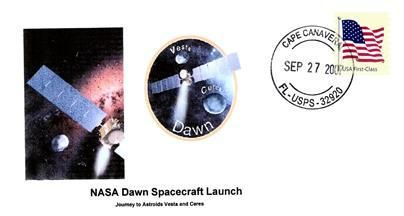Space Cover 328: Dawn Arrives at CeresNew Horizons' flyby of Pluto received a lot of press coverage — and rightly so — but there was another big event in deep space exploration in 2015: the Dawn spacecraft arrival at Ceres.
Dawn is a deep space probe launched by NASA on September 27, 2007 with the mission of studying two of the three known protoplanets of the asteroid belt, Vesta and Ceres. It is currently in orbit above the dwarf planet Ceres. Dawn is the first spacecraft to orbit two extraterrestrial bodies, the first spacecraft to visit either Vesta or Ceres, and also the first to visit a dwarf planet, arriving at Ceres in March 2015, a few months before New Horizons flew by Pluto in July 2015.
Dawn entered Vesta orbit on July 16, 2011, and completed a 14-month survey mission before leaving for Ceres in late 2012. Dawn entered Ceres orbit on March 6, 2015.
The Dawn spacecraft is propelled by three xenon ion thrusters based on an evolution of the technology used by the Deep Space 1 spacecraft, using only one of them at a time. Dawn was allocated 606 lbs of xenon for its Vesta approach, and carried another 243 lbs to reach Ceres, out of a total capacity of 937 lbs of on-board propellant. With the propellant it carries, Dawn can perform a velocity change of more than 10 km/s over the course of its mission, far more than any previous spacecraft achieved with onboard propellant after separation from its launch rocket. Dawn is NASA's first purely exploratory mission to use ion propulsion engines. The spacecraft also has twelve hydrazine thrusters for attitude control, which were designed to assist in orbital insertion.
Dawn's ion propulsion enabled it to enter and leave the orbit of multiple celestial bodies. Previous multi-target missions using conventional drives, such as the Mariner and Voyager programs, were restricted to flybys.
Dawn is the ninth Discovery mission in NASA’s Science Mission Directorate and is a collaborative partnership made up of the University of California, Los Angeles; Jet Propulsion Laboratory; Orbital Sciences Corporation; Los Alamos National Laboratory; German Aerospace Center; Max Planck Institute for Solar System Research; Italian Space Agency; and Italian National Institute of Astrophysics.













